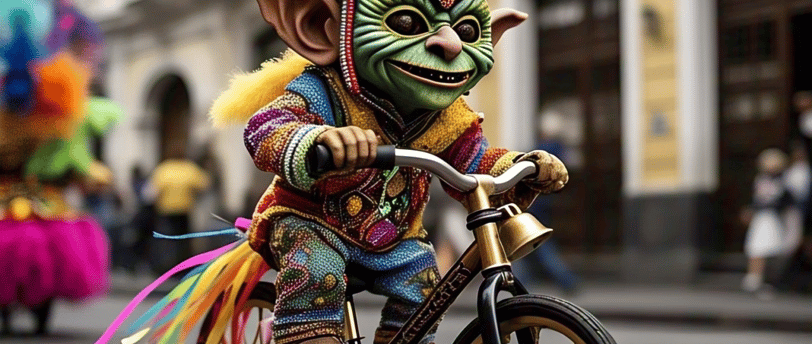The Bicycle Goblin and the Carnival of Quito
In the cobblestone and colorful streets of Quito’s Historic Center, where colonial balconies are adorned with geraniums and church bells whisper to the wind, a peculiar legend awakens every Carnival
Ronnie Camino
3/3/20254 min read


In the cobblestone and colorful streets of Quito’s Historic Center, where colonial balconies are adorned with geraniums and church bells whisper to the wind, a peculiar legend awakens every Carnival: the tale of the Bicycle Goblin.
The elders of the neighborhood say that when parades fill the streets with rhythms and streamers fall like a rain of colors, a small being with a green hat and a leather jacket appears, riding an old bicycle. His bike, a gleaming velocipede with golden spokes and a bell that sounds like crystal chimes, cuts through the air with magical lightness.
The goblin, known as Pedalín, is no ordinary creature. It is said he is the spirit of an ancient cyclist who, centuries ago, roamed Quito when bicycles were a luxury, and the steep streets of the city were a challenge reserved for the brave. Pedalín had an immense love for the freedom of the wheels, and his eternal wish was for everyone to feel the breeze of Quito on their faces while riding.
Every Carnival, as the bands play and dancers wear vibrant costumes, Pedalín emerges among the crowd. Not everyone can see him, but those who do say his bicycle doesn’t touch the ground; instead, it hovers just a few centimeters above, leaving a trail of golden sparks.
Once, Edwin, an eight-year-old boy with a stuck bicycle and broken brakes, found himself amid the bustling Carnival. The slope of García Moreno Street seemed like an endless slide, and fear clung to his skin. Just when he felt lost, a gentle push stopped him.
"Need some help, friend?" a soft voice asked.
Edwin looked and saw the tiny goblin, his eyes shining as brightly as the stars over Quito. Before he could respond, Pedalín touched the boy’s bike, and immediately the brakes worked like new, the chain stopped squeaking, and even the bell rang joyfully.
"Keep pedaling, but never without a smile," said the goblin, and with a wink, he vanished back into the crowd.
Since then, every Carnival, Edwin participates in a group bike ride he now organizes with his friends. They ride together, paying close attention to the velocipedes, hoping for a golden sparkle among the wheels. And although no one has seen Pedalín directly since then, every year, at the end of the ride, they always find golden petals at the starting point—a reminder that the Bicycle Goblin is still there, wandering the historic streets of Quito, bringing with him the magic of the pedal and the joy of Carnival.
ESPAÑOL: El Duende de la Bicicleta y el Carnaval de Quito
En las empedradas y coloridas calles del Centro Histórico de Quito, donde los balcones coloniales se visten de geranios y las campanas de las iglesias susurran al viento, existe una leyenda que despierta cada Carnaval: la del Duende de la Bicicleta.
Dicen los más viejos del barrio que, cuando las comparsas inundan las calles con sus ritmos y las serpentinas caen como lluvia de colores, un pequeño ser de gorro verde y chaqueta de cuero aparece montado en una bicicleta antigua. Su bici, un reluciente velocípedo con rayos dorados y un timbre que suena como campanas de cristal, corta el aire con una ligereza mágica.
El duende, conocido como Pedalín, no es un ser cualquiera. Cuentan que es el espíritu de un antiguo ciclista que, hace siglos, recorría Quito cuando aún las bicicletas eran un lujo y las cuestas de la ciudad un desafío reservado para los valientes. Pedalín tenía un amor inmenso por la libertad de las ruedas, y su deseo eterno era que todos pudieran sentir la brisa de Quito en el rostro mientras pedaleaban.
Cada Carnaval, mientras las bandas tocan y los bailarines visten trajes brillantes, Pedalín surge entre la multitud. No todos pueden verlo, pero aquellos que lo logran dicen que su bicicleta no toca el suelo, sino que flota apenas unos centímetros, dejando un rastro de chispas doradas.
Una vez, Edwin, un niño de ocho años con su bicicleta atascada y sin frenos, se encontró en medio del bullicio del Carnaval. La pendiente de la calle García Moreno parecía un tobogán interminable, y el miedo se le pegó a la piel. Cuando ya se sentía perdido, un suave empujón lo detuvo.
—¿Necesitas ayuda, amigo? —dijo una voz suave.
Edwin miró y vio al pequeño duende, sus ojos tan brillantes como las estrellas de Quito. Antes de que pudiera responder, Pedalín tocó la bicicleta del niño, y de inmediato los frenos funcionaron como nuevos, la cadena dejó de chirriar y hasta el timbre volvió a sonar alegremente.
—Sigue pedaleando, pero nunca sin una sonrisa —le dijo el duende, y con un guiño, volvió a perderse entre la muchedumbre.
Desde entonces, cada Carnaval, Edwin participa en una bicicleteada que ahora organiza con sus amigos. Todos ruedan juntos prestando atención a los velocípedos, esperando quizás un destello dorado entre las ruedas. Y aunque nadie ha vuelto a ver a Pedalín directamente, cada año, al finalizar el recorrido, siempre encuentran pétalos dorados en el punto de partida, un recordatorio de que el Duende de la Bicicleta sigue allí, recorriendo las históricas calles de Quito, llevando con él la magia del pedal y la alegría del Carnaval.
